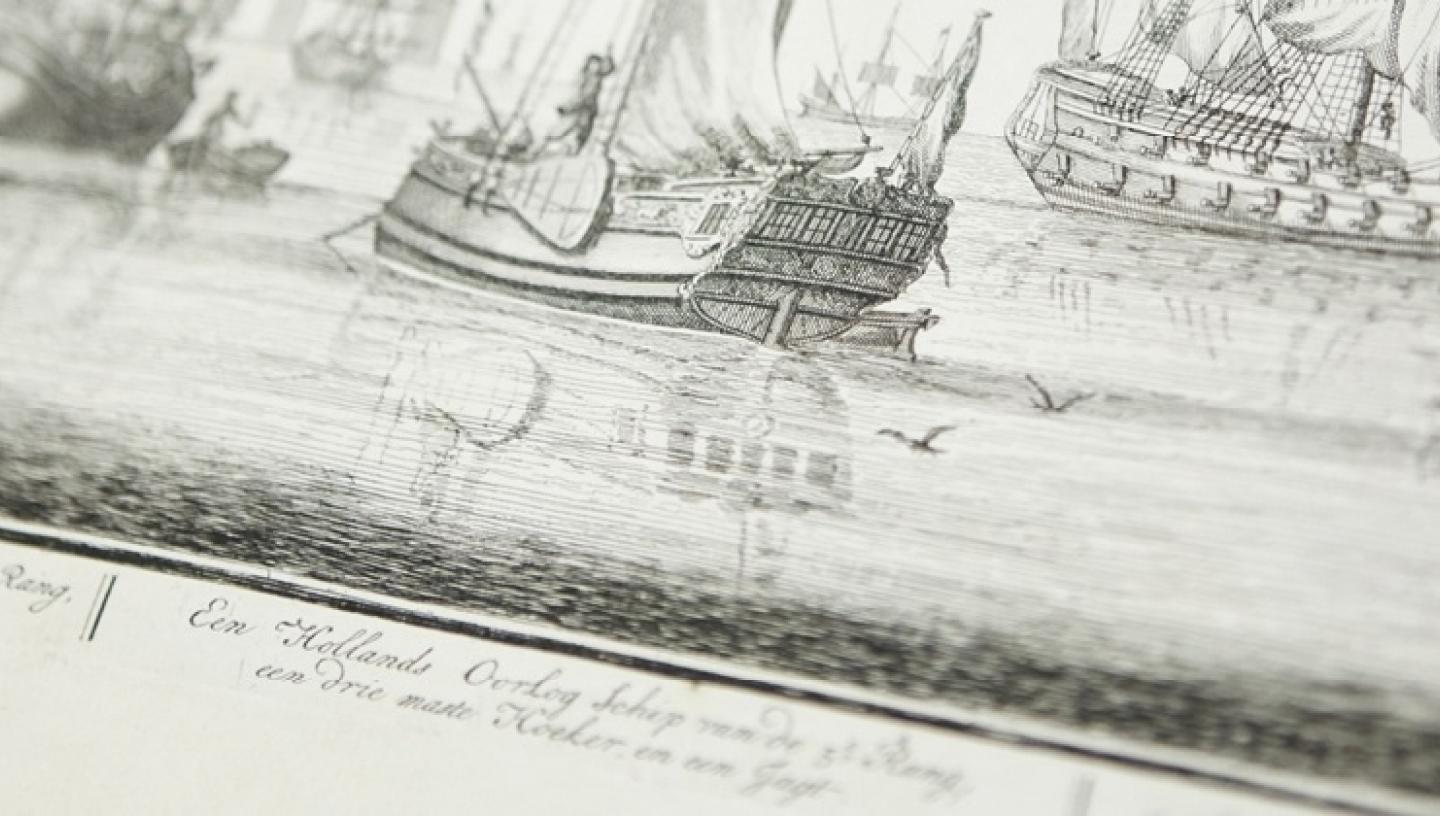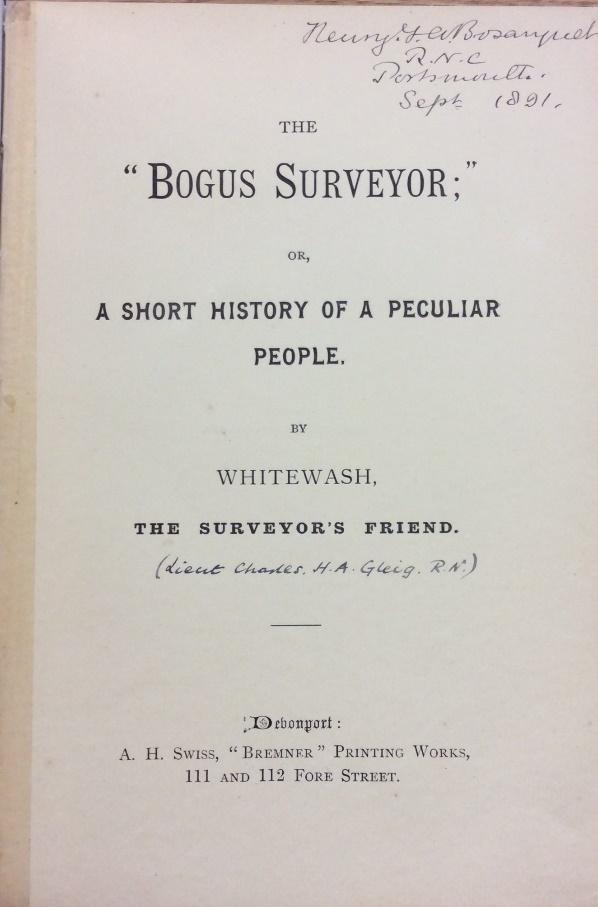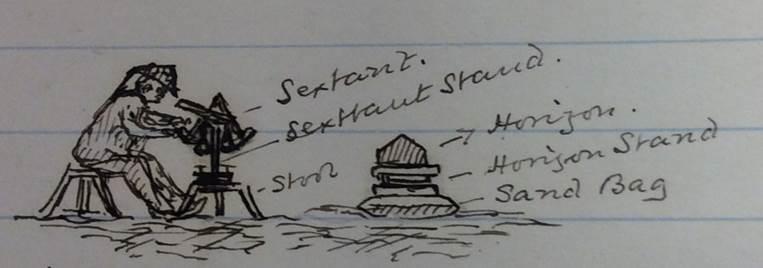
03 Apr 2019
“If, by repeated efforts, you find the index [of the theodolite] will not return to zero after taking a round of angles…unscrew the instrument from its tripod and replace it in the box, close the lid firmly, then gently roll the box one hundred yards or so down the hill side…”
This, to say the least, is unorthodox advice about the management of instruments in marine surveying. In the pages of the anonymously published The Bogus Surveyor (1890), a small volume in the Caird Library’s collection, it forms part of a satirical account of life on board a surveying vessel in the late 19th century. Playing on a large corpus of etiquette literature and a number of surveying manuals, The Bogus Surveyor also offers advice to the young officer on conversation, conduct and dress.
By Megan Barford, Curator of Cartography
Visit the Caird Library and Archive

The Caird Library’s copy of this volume is part of the collection of Henry Theodore Augustus Bosanquet (1870-1959), who had entered the Royal Navy in 1883, and served on a surveying vessel, Paluma, between 1892-4. His own notes from the survey are typical of the sort of training which junior officers underwent on surveying voyages: diagrams of how to construct tide-poles, descriptions of different sorts of instruments and how to treat them, suggestions of how, using whitewash or large pieces of canvas, marks for triangulation could be set up along a coastline.

Henry Bosanquet's sketch of observing with a sextant (RMG ID: BOS/13)
It was in the first half of the 19th century that a distinctive corps of hydrographic surveyors developed within the Royal Navy, under the direction of the Hydrographer to the Navy, who came to coordinate surveying voyages to regions of particular colonial, commercial or strategic interest, and to organise the publication and distribution of printed charts. Surveyors also developed something of a distinctive identity, and complained of being mocked for caring too much about angles, and theodolites, and areas of coastline little visited by the Royal Navy.
By the end of the 19th century, this distinctiveness had grown even more pronounced, in a context of a denigration of specialist expertise as contrary to the character of a gentleman. The cultivation of ‘character’ among officers in the late Victorian Royal Navy focused on upper-middle-class values of duty, self-control and a specific, learned set of social skills which were known as ‘good manners’. Such manners included a highly refined sense of dress and an understanding of what sorts of conversation were appropriate for gentlemen.
Where earlier in the 19th century a cultivated scientific identity could be a way into polite society, by the 1890s specialist, technical talk, especially in the Royal Navy, was clearly a faux pas. Remarking that “even as ‘Attitude is the art of Gunnery’ so may it be said that ‘Bunkum is the secret of Surveying’”, The Bogus Surveyor observes and advises about conversation on board a surveying vessel. It plays exactly on a disdain for specialism which for upper-middle-class officers was too close to a trade and thus a class identity they worked hard to distinguish themselves from. It does this by suggesting how much can be faked, recommending interjections in conversation
“in this style: “I say Jones, was that your whitewash mark on Saucepan Rock? It showed splendidly.” “Smith, what was your angle at Cliff Station between Hyde Peak and Sandhill?” or between anything no matter what. “That theodolite of mine worked splendidly today, I wouldn’t change it for any other” and so forth.”
Dwelling on the sartorial idiosyncrasy of the marine surveyor also helped to emphasise how peculiar a group they were. In a world where a suit, collar and tie were the basis of gentlemanly dress, the description of the “truly wonderful garb” of the surveyor – comprising “a Baltic shirt (without collar), a pair of flannel knickerbockers, ship’s stockings, and a sun helmet” – was gently scandalous. Of the captain who once suggested that surveying officers might work in uniform, the Bogus gravely reported “it is said that he never obtained another command.”
The Bogus Surveyor combines ebullient “solutions” to technical problems (roll the theodolite down the hill) and unwavering mockery of the seriousness with which surveyors viewed their profession. In case the point about how this jarred with the prevailing values of officers at the time, the parting advice to a young officer about to enter a surveying ship was that
“A general ignorance of the customs of the Service usually characterises the true surveyor. Endeavour to forget as rapidly as possible the ways in which you have been brought up in a man-of-war.”
The Bogus Surveyor jokingly showed officers how they could pretend to be a surveyor. In doing so, it also – quite bitingly – suggested to them why they might not want to.
The Caird Library and Archive holds several collections of surveyors’ personal papers (including John Lort Stokes, Richard Collinson, Arthur Mostyn Field), as well as an extensive collection of Admiralty Charts. Alongside these collections, The Bogus Surveyor offers another way into thinking about the place of hydrography in the Royal Navy. Alongside that, it also allows us to think about the history of elite attitudes towards specialism and expertise.